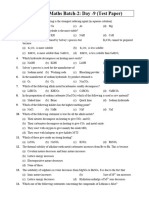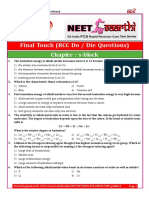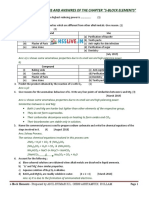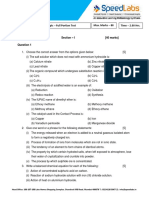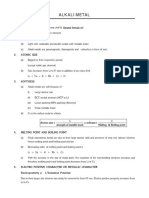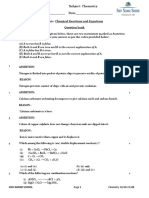The S-Block Elements
Uploaded by
Shravani KThe S-Block Elements
Uploaded by
Shravani K
I. Multiple Choice Questions (Type-I)
1. The alkali metals are low melting. Which of the following alkali metal is expected
to melt if the room temperature rises to 30°C?
(i) Na
(ii) K
(iii) Rb
(iv) Cs
2. Alkali metals react with water vigorously to form hydroxides and dihydrogen.
Which of the following alkali metals reacts with water least vigorously?
(i) Li
(ii) Na
(iii) K
(iv) Cs
3. The reducing power of a metal depends on various factors. Suggest the factor
which makes Li, the strongest reducing agent in aqueous solution.
(i) Sublimation enthalpy
(ii) Ionisation enthalpy
(iii) Hydration enthalpy
(iv) Electron-gain enthalpy
4. Metal carbonates decompose on heating to give metal oxide and carbon
dioxide. Which of the metal carbonates is most stable thermally?
(i) MgCO3
(ii) CaCO3
(iii) SrCO3
(iv) BaCO3
16-04-2018
Click on this link to buy latest Educart Books on Amazon - https://amzn.to/399Osrj
5. Which of the carbonates given below is unstable in air and is kept in CO2
atmosphere to avoid decomposition.
(i) BeCO3
(ii) MgCO3
(iii) CaCO3
(iv) BaCO3
6. Metals form basic hydroxides. Which of the following metal hydroxide is the
least basic?
(i) Mg(OH)2
(ii) Ca(OH)2
(iii) Sr(OH)2
(iv) Ba(OH)2
7. Some of the Group 2 metal halides are covalent and soluble in organic solvents.
Among the following metal halides, the one which is soluble in ethanol is
(i) BeCl2
(ii) MgCl2
(iii) CaCl2
(iv) SrCl2
8. The order of decreasing ionisation enthalpy in alkali metals is
(i) Na > Li > K > Rb
(ii) Rb < Na < K < Li
(iii) Li > Na > K > Rb
(iv) K < Li < Na < Rb
9. The solubility of metal halides depends on their nature, lattice enthalpy and
hydration enthalpy of the individual ions. Amongst fluorides of alkali metals,
the lowest solubility of LiF in water is due to
(i) Ionic nature of lithium fluoride
(ii) High lattice enthalpy
(iii) High hydration enthalpy for lithium ion.
(iv) Low ionisation enthalpy of lithium atom
10. Amphoteric hydroxides react with both alkalies and acids. Which of the
following Group 2 metal hydroxides is soluble in sodium hydroxide?
(i) Be(OH)2
(ii) Mg(OH)2
(iii) Ca(OH)2
(iv) Ba(OH)2
Exemplar Problems, Chemistry 126
16-04-2018
Click on this link to buy latest Educart Books on Amazon - https://amzn.to/399Osrj
11. In the synthesis of sodium carbonate, the recovery of ammonia is done by
treating NH4Cl with Ca(OH)2. The by-product obtained in this process is
(i) CaCl2
(ii) NaCl
(iii) NaOH
(iv) NaHCO3
12. When sodium is dissolved in liquid ammonia, a solution of deep blue colour
is obtained. The colour of the solution is due to
(i) ammoniated electron
(ii) sodium ion
(iii) sodium amide
(iv) ammoniated sodium ion
13. By adding gypsum to cement
(i) setting time of cement becomes less.
(ii) setting time of cement increases.
(iii) colour of cement becomes light.
(iv) shining surface is obtained.
14. Dead burnt plaster is
(i) CaSO4
1
(ii) CaSO4. HO
2 2
(iii) CaSO4.H2O
(iv) CaSO4.2H2O
15. Suspension of slaked lime in water is known as
(i) lime water
(ii) quick lime
(iii) milk of lime
(iv) aqueous solution of slaked lime
16. Which of the following elements does not form hydride by direct heating with
dihydrogen?
(i) Be
(ii) Mg
(iii) Sr
(iv) Ba
127 The s-Block Elements
16-04-2018
Click on this link to buy latest Educart Books on Amazon - https://amzn.to/399Osrj
17. The formula of soda ash is
(i) Na2CO3.10H2O
(ii) Na2CO3.2H2O
(iii) Na2CO3.H2O
(iv) Na2CO3
18. A substance which gives brick red flame and breaks down on heating to give
oxygen and a brown gas is
(i) Magnesium nitrate
(ii) Calcium nitrate
(iii) Barium nitrate
(iv) Strontium nitrate
19. Which of the following statements is true about Ca(OH)2?
(i) It is used in the preparation of bleaching powder
(ii) It is a light blue solid
(iii) It does not possess disinfectant property.
(iv) It is used in the manufacture of cement.
20. A chemical A is used for the preparation of washing soda to recover ammonia.
When CO2 is bubbled through an aqueous solution of A, the solution turns
milky. It is used in white washing due to disinfectant nature. What is the
chemical formula of A?
(i) Ca (HCO3)2
(ii) CaO
(iii) Ca(OH)2
(iv) CaCO3
21. Dehydration of hydrates of halides of calcium, barium and strontium i.e.,
CaCl26H2O, BaCl2.2H2O, SrCl2.2H2O, can be achieved by heating. These
become wet on keeping in air. Which of the following statements is correct
about these halides?
(i) act as dehydrating agent
(ii) can absorb moisture from air
(iii) Tendency to form hydrate decreases from calcium to barium
(iv) All of the above
II. Multiple Choice Questions (Type-II)
In the following questions two or more options may be correct.
22. Metallic elements are described by their standard electrode potential, fusion
enthalpy, atomic size, etc. The alkali metals are characterised by which of the
following properties?
Exemplar Problems, Chemistry 128
16-04-2018
Click on this link to buy latest Educart Books on Amazon - https://amzn.to/399Osrj
(i) High boiling point
(ii) High negative standard electrode potential
(iii) High density
(iv) Large atomic size
23. Several sodium compounds find use in industries. Which of the following
compounds are used for textile industry?
(i) Na2CO3
(ii) NaHCO3
(iii) NaOH
(iv) NaCl
24. Which of the following compounds are readily soluble in water?
(i) BeSO4
(ii) MgSO4
(iii) BaSO4
(iv) SrSO4
25. When Zeolite, which is hydrated sodium aluminium silicate is treated with
hard water, the sodium ions are exchanged with which of the following ion(s)?
+
(i) H ions
2+
(ii) Mg ions
2+
(iii) Ca ions
(iv) SO2–
4
ions
26. Identify the correct formula of halides of alkaline earth metals from the following.
(i) BaCl2.2H2O
(ii) BaCl2.4H2O
(iii) CaCl2.6H2O
(iv) SrCl2.4H2O
27. Choose the correct statements from the following.
(i) Beryllium is not readily attacked by acids because of the presence of
an oxide film on the surface of the metal.
(ii) Beryllium sulphate is readily soluble in water as the greater hydration
2+
enthalpy of Be overcomes the lattice enthalpy factor.
(iii) Beryllium exhibits coordination number more than four.
(iv) Beryllium oxide is purely acidic in nature.
28. Which of the following are the correct reasons for anomalous behaviour of lithium?
(i) Exceptionally small size of its atom
(ii) Its high polarising power
(iii) It has high degree of hydration
(iv) Exceptionally low ionisation enthalpy
129 The s-Block Elements
16-04-2018
Click on this link to buy latest Educart Books on Amazon - https://amzn.to/399Osrj
III. Short Answer Type
29. How do you account for the strong reducing power of lithium in aqueous
solution?
30. When heated in air, the alkali metals form various oxides. Mention the oxides
formed by Li, Na and K.
31. Complete the following reactions
2– –
(i) O2 + H2O → (ii) O2 + H2O →
32. Lithium resembles magnesium in some of its properties. Mention two such
properties and give reasons for this resemblance.
33. Name an element from Group 2 which forms an amphoteric oxide and a water
soluble sulphate.
34. Discuss the trend of the following:
(i) Thermal stability of carbonates of Group 2 elements.
(ii) The solubility and the nature of oxides of Group 2 elements.
35. Why are BeSO4 and MgSO4 readily soluble in water while CaSO4, SrSO4 and
BaSO4 are insoluble?
36. All compounds of alkali metals are easily soluble in water but lithium
compounds are more soluble in organic solvents. Explain.
37. In the Solvay process, can we obtain sodium carbonate directly by treating
the solution containing (NH4)2CO3 with sodium chloride? Explain.
–
38. Write Lewis strucure of O2 ion and find out oxidation state of each oxygen
atom? What is the average oxidation state of oxygen in this ion?
39. Why do beryllium and magnesium not impart colour to the flame in the flame test?
40. What is the structure of BeCl2 molecule in gaseous and solid state?
IV. Matching Type
In the following questions more than one option of column I and II may be
correlated.
41. Match the elements given in Column I with the properties mentioned in Column II.
Column I Column II
(i) Li (a) Insoluble sulphate
(ii) Na (b) Strongest monoacidic base
(iii) Ca (c) Most negative E value among alkali
metals.
(iv) Ba (d) Insoluble oxalate
2
(e) 6s outer electronic configuration
Exemplar Problems, Chemistry 130
16-04-2018
Click on this link to buy latest Educart Books on Amazon - https://amzn.to/399Osrj
42. Match the compounds given in Column I with their uses mentioned in Column II.
Column I Column II
(i) CaCO3 (a) Dentistry, ornamental work
(ii) Ca(OH)2 (b) Manufacture of sodium carbonate from
caustic soda
(iii) CaO (c) Manufacture of high quality paper
(iv) CaSO4 (d) Used in white washing
43. Match the elements given in Column I with the colour they impart to the
flame given in Column II.
Column I Column II
(i) Cs (a) Apple green
(ii) Na (b) Violet
(iii) K (c) Brick red
(iv) Ca (d) Yellow
(v) Sr (e) Crimson red
(vi) Ba (f) Blue
V. Assertion and Reason Type
In the following questions a statement of Assertion (A) followed by a statement
of Reason (R) is given. Choose the correct option out of the choices given
below each question.
44. Assertion (A): The carbonate of lithium decomposes easily on heating to
form lithium oxide and CO2.
Reason (R) : Lithium being very small in size polarises large carbonate
ion leading to the formation of more stable Li2O and CO2.
(i) Both A and R are correct and R is the correct explanation of A.
(ii) Both A and R are correct but R is not the correct explanation of A.
(iii) Both A and R are not correct
(iv) A is not correct but R is correct.
45. Assertion (A): Beryllium carbonate is kept in the atmosphere of carbon
dioxide.
Reason (R) : Beryllium carbonate is unstable and decomposes to give
beryllium oxide and carbon dioxide.
(i) Both A and R are correct and R is the correct explanation of A.
(ii) Both A and R are correct but R is not the correct explanation of A.
(iii) Both A and R are not correct.
(iv) A is not correct but R is correct.
131 The s-Block Elements
16-04-2018
Click on this link to buy latest Educart Books on Amazon - https://amzn.to/399Osrj
VI. Long Answer Type
46. The s-block elements are characterised by their larger atomic sizes, lower
ionisation enthalpies, invariable +1 oxidation state and solubilities of their
oxosalts.In the light of these features describe the nature of their oxides,
halides and oxosalts.
47. Present a comparative account of the alkali and alkaline earth metals with
respect to the following characteristics:
(i) Tendency to form ionic / covalent compounds
(ii) Nature of oxides and their solubility in water
(iii) Formation of oxosalts
(iv) Solubility of oxosalts
(v) Thermal stability of oxosalts
48. When a metal of group 1 was dissolved in liquid ammonia, the following
observations were obtained:
(i) Blue solution was obtained initially.
(ii) On concentrating the solution, blue colour changed to bronze colour.
How do you account for the blue colour of the solution? Give the name of the
product formed on keeping the solution for some time.
49. The stability of peroxide and superoxide of alkali metals increase as we go
down the group. Explain giving reason.
50. When water is added to compound (A) of calcium, solution of compound (B)
is formed. When carbon dioxide is passed into the solution, it turns milky
due to the formation of compound (C). If excess of carbon dioxide is passed
into the solution milkiness disappears due to the formation of compound
(D). Identify the compounds A, B, C and D. Explain why the milkiness
disappears in the last step.
51. Lithium hydride can be used to prepare other useful hydrides. Beryllium
hydride is one of them. Suggest a route for the preparation of beryllium hydride
starting from lithium hydride. Write chemical equations involved in the process.
52. An element of group 2 forms covalent oxide which is amphoteric in nature
and dissolves in water to give an amphoteric hydroxide. Identify the element
and write chemical reactions of the hydroxide of the element with an alkali
and an acid.
53. Ions of an element of group 1 participate in the transmission of nerve signals
and transport of sugars and aminoacids into cells. This element imparts yellow
colour to the flame in flame test and forms an oxide and a peroxide with
oxygen. Identify the element and write chemical reaction to show the formation
of its peroxide. Why does the element impart colour to the flame?
Exemplar Problems, Chemistry 132
16-04-2018
Click on this link to buy latest Educart Books on Amazon - https://amzn.to/399Osrj
ANSWERS
I. Multiple Choice Questions (Type-I)
1. (iv) 2. (i) 3. (iii) 4. (iv) 5. (i) 6. (i)
7. (i) 8. (iii) 9. (ii) 10. (i) 11. (i) 12. (i)
13. (ii) 14. (i) 15. (iii) 16. (i) 17. (iv) 18. (ii)
19. (i) 20. (iii) 21. (iv)
II. Multiple Choice Questions (Type-II)
22. (ii), (iv) 23. (i), (iii) 24. (i), (ii) 25. (ii), (iii)
26. (i), (iii) 27. (i), (ii) 28. (i), (ii)
III. Short Answer Type
2– –
31. (i) O2 + 2H2O → 2OH + H2O2
– –
(ii) 2O2 + 2H2O → 2OH + H2O2 + O2
IV. Matching Type
41. (i)→ (c), (ii)→ (b), (iii)→(d), (iv)→(a), (e)
42. (i)→ (c), (ii) → (d), (iii) → (b), (iv) → (a)
43. (i)→ (f), (ii) → (d), (iii) → (b), (iv) → (c)
(v)→ (e), (vi) → (a)
V. Assertion and Reason Type
44. (i) 45. (i)
VI. Long Answer Type
50. Compound : A : CaO; B : Ca (OH)2 ; C : CaCO3 ; D : Ca(HCO3)2
Ca(HCO3)2 is soluble in water. Hence, milkiness of solution disappears on
passing excess carbon dioxide into the solution of compound B.
51. 8 LiH + Al2Cl6 → 2Li Al H4 + 6 LiCl
LiAl H4 + 2BeCl2 → 2BeH2 + LiCl + AlCl3
52. The element is beryllium
53. The element is sodium.
133 The s-Block Elements
16-04-2018
Click on this link to buy latest Educart Books on Amazon - https://amzn.to/399Osrj
You might also like
- Analysing Political Speeches Rhetoric, Discourse and Metaphor (Jonathan Charteris-Black) (Z-Library)No ratings yetAnalysing Political Speeches Rhetoric, Discourse and Metaphor (Jonathan Charteris-Black) (Z-Library)314 pages
- Final Touch (RCC Do / Die Questions) Chapter: S-BlockNo ratings yetFinal Touch (RCC Do / Die Questions) Chapter: S-Block13 pages
- 2358644-Class 10 Chemistry Metals and Non Metals Ws AshaNo ratings yet2358644-Class 10 Chemistry Metals and Non Metals Ws Asha10 pages
- MODULE 3 class 10.docx_20241024_052710_0000No ratings yetMODULE 3 class 10.docx_20241024_052710_00007 pages
- Hsslive-Xi-Chem-Ch-10. S-Block Elements-Signed100% (1)Hsslive-Xi-Chem-Ch-10. S-Block Elements-Signed7 pages
- Icse X Chemistry: ICSE Board Class X Chemistry Board Paper Solution - 2018 Time: 2 Hrs. Max. Marks: 80 Section I Answer 1No ratings yetIcse X Chemistry: ICSE Board Class X Chemistry Board Paper Solution - 2018 Time: 2 Hrs. Max. Marks: 80 Section I Answer 19 pages
- Padhle 10th - Chemical Reactions and Equations - DPPNo ratings yetPadhle 10th - Chemical Reactions and Equations - DPP4 pages
- HSSRPTR - Oxy Chem - Worksheet Series - 4No ratings yetHSSRPTR - Oxy Chem - Worksheet Series - 42 pages
- Subjective Test 02 _ Test Paper (Chemistry) __ PDF Only __ (Radiant 2024)No ratings yetSubjective Test 02 _ Test Paper (Chemistry) __ PDF Only __ (Radiant 2024)2 pages
- Chemistry SCIENCE Paper - 2: Answers To This Paper Must Be Written On The Paper Provided SeparatelyNo ratings yetChemistry SCIENCE Paper - 2: Answers To This Paper Must Be Written On The Paper Provided Separately8 pages
- Arihant - Class X - Chemical Reactions and Equations (Chapter - 1)No ratings yetArihant - Class X - Chemical Reactions and Equations (Chapter - 1)12 pages
- Metals and Non-Metals: Multiple Choice QuestionsNo ratings yetMetals and Non-Metals: Multiple Choice Questions10 pages
- ICSE10 - Chemistry - Full Portion Test Paper - 01No ratings yetICSE10 - Chemistry - Full Portion Test Paper - 015 pages
- 9th Std Chemistry- Final Assessment 2024No ratings yet9th Std Chemistry- Final Assessment 20245 pages
- 64cb839298d6ff0018bcc44f_##_Metallurgy : Practice Sheet || Lakshya JEE 2024No ratings yet64cb839298d6ff0018bcc44f_##_Metallurgy : Practice Sheet || Lakshya JEE 20244 pages
- Class: 10 Subject: Chemistry Name - DateNo ratings yetClass: 10 Subject: Chemistry Name - Date3 pages
- Chapter Three Chapter Three The Multiple Linear Regression (MLR)No ratings yetChapter Three Chapter Three The Multiple Linear Regression (MLR)50 pages
- Group-Contribution Estimation of Activity Coefficients in Nonideal Liquid Mixtures. Aiche 1975No ratings yetGroup-Contribution Estimation of Activity Coefficients in Nonideal Liquid Mixtures. Aiche 197514 pages
- Complete Download Algebraic Topology VIASM 2012 2015 1st Edition H.V. Hưng Nguyễn PDF All Chapters100% (6)Complete Download Algebraic Topology VIASM 2012 2015 1st Edition H.V. Hưng Nguyễn PDF All Chapters62 pages
- New Twists in The Unfolded Protein Response: Cell BiologyNo ratings yetNew Twists in The Unfolded Protein Response: Cell Biology4 pages
- Brand Awareness & Preference Regarding Havells Green CFL PDF100% (1)Brand Awareness & Preference Regarding Havells Green CFL PDF74 pages
- Agrement For Sale - First Floor Office 1 - RA Busines PArk 800722No ratings yetAgrement For Sale - First Floor Office 1 - RA Busines PArk 80072262 pages
- 11-09-2022 - SR - Super60 - Jee-Adv (2020-P2) - RPTA-01 - Key & Sol'sNo ratings yet11-09-2022 - SR - Super60 - Jee-Adv (2020-P2) - RPTA-01 - Key & Sol's10 pages
- Analysing Political Speeches Rhetoric, Discourse and Metaphor (Jonathan Charteris-Black) (Z-Library)Analysing Political Speeches Rhetoric, Discourse and Metaphor (Jonathan Charteris-Black) (Z-Library)
- Final Touch (RCC Do / Die Questions) Chapter: S-BlockFinal Touch (RCC Do / Die Questions) Chapter: S-Block
- 2358644-Class 10 Chemistry Metals and Non Metals Ws Asha2358644-Class 10 Chemistry Metals and Non Metals Ws Asha
- Icse X Chemistry: ICSE Board Class X Chemistry Board Paper Solution - 2018 Time: 2 Hrs. Max. Marks: 80 Section I Answer 1Icse X Chemistry: ICSE Board Class X Chemistry Board Paper Solution - 2018 Time: 2 Hrs. Max. Marks: 80 Section I Answer 1
- Padhle 10th - Chemical Reactions and Equations - DPPPadhle 10th - Chemical Reactions and Equations - DPP
- Subjective Test 02 _ Test Paper (Chemistry) __ PDF Only __ (Radiant 2024)Subjective Test 02 _ Test Paper (Chemistry) __ PDF Only __ (Radiant 2024)
- Chemistry SCIENCE Paper - 2: Answers To This Paper Must Be Written On The Paper Provided SeparatelyChemistry SCIENCE Paper - 2: Answers To This Paper Must Be Written On The Paper Provided Separately
- Arihant - Class X - Chemical Reactions and Equations (Chapter - 1)Arihant - Class X - Chemical Reactions and Equations (Chapter - 1)
- 64cb839298d6ff0018bcc44f_##_Metallurgy : Practice Sheet || Lakshya JEE 202464cb839298d6ff0018bcc44f_##_Metallurgy : Practice Sheet || Lakshya JEE 2024
- Chapter Three Chapter Three The Multiple Linear Regression (MLR)Chapter Three Chapter Three The Multiple Linear Regression (MLR)
- Group-Contribution Estimation of Activity Coefficients in Nonideal Liquid Mixtures. Aiche 1975Group-Contribution Estimation of Activity Coefficients in Nonideal Liquid Mixtures. Aiche 1975
- Complete Download Algebraic Topology VIASM 2012 2015 1st Edition H.V. Hưng Nguyễn PDF All ChaptersComplete Download Algebraic Topology VIASM 2012 2015 1st Edition H.V. Hưng Nguyễn PDF All Chapters
- New Twists in The Unfolded Protein Response: Cell BiologyNew Twists in The Unfolded Protein Response: Cell Biology
- Brand Awareness & Preference Regarding Havells Green CFL PDFBrand Awareness & Preference Regarding Havells Green CFL PDF
- Agrement For Sale - First Floor Office 1 - RA Busines PArk 800722Agrement For Sale - First Floor Office 1 - RA Busines PArk 800722
- 11-09-2022 - SR - Super60 - Jee-Adv (2020-P2) - RPTA-01 - Key & Sol's11-09-2022 - SR - Super60 - Jee-Adv (2020-P2) - RPTA-01 - Key & Sol's




